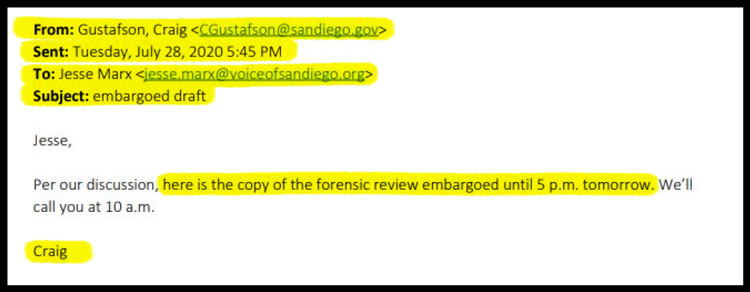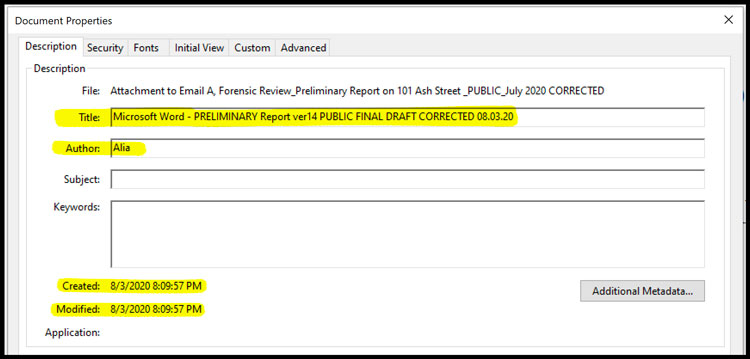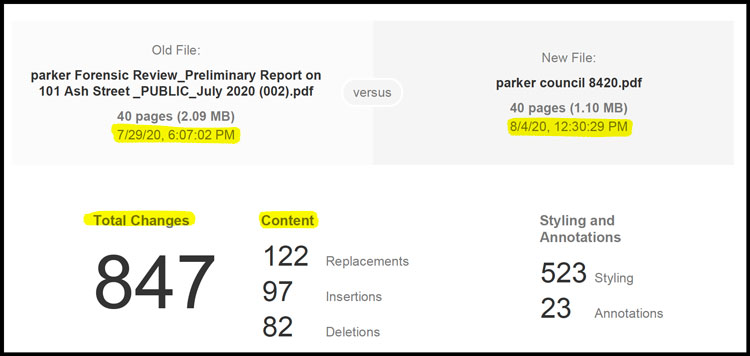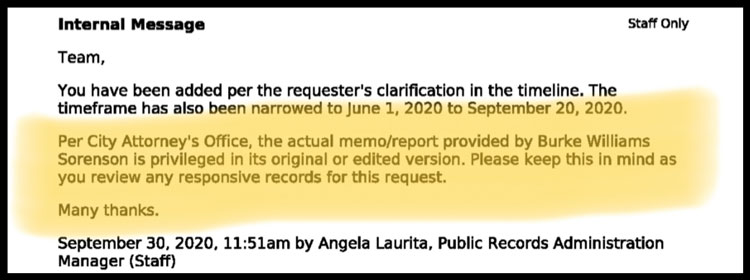II B or Not II B: Revised Report Raises Questions About Independence of 101 Ash St Investigations

An independent report conducted to review the controversial 101 Ash St building transaction was amended several times after it was first presented to the City, raising questions about whether City staff – including individuals who were subject to being investigated for their role in the transaction – played a role in modifying the external report before the City Council and the public saw the final version.
The report, drafted by attorney James Parker of Hugo Parker, LLP, was to document his findings after reviewing two independent reports by other outside law firms: Burke Williams Sorensen, and Procopio Cory Hargreaves & Savitch. The investigations examined the actions of the City Council, City staff, and the City Attorney’s office in the process of negotiating, contracting, renovating, and moving into the building.
The City Council held a closed session with Parker on the morning of July 28, 2020, to discuss “Significant Exposure to Litigation” and “Anticipated Litigation” in relation to “the renovation and occupancy of its 101 Ash Street property” as outlined in the meeting agenda. Minutes of the meeting do not reflect whether the Councilmembers reviewed a draft of Parker’s report.
But later that day, Craig Gustafson, Mayor Kevin Faulconer’s Communications Director, emailed a copy of the report to Jesse Marx, a reporter with the online news outlet Voice of San Diego. Gustafson’s email at 5:45 pm required Marx to embargo, or hold, the report from publication until at least 5:00 pm the next day, July 29th.

The metadata information embedded in the document show that the PDF file was created by James Parker on July 28th at 5:33 pm, modified at 5:36 pm, and saved using Acrobat PDF Maker 20 for Word. The copy was sent to Marx just nine minutes after Parker appears to have last saved the document.
The next day on July 29th, Thomas Jones, Executive Investigative Producer for NBC7/39, emailed Gustafson stating that his news station had reviewed copies of all three reports, asked for comments from the Mayor in response to the reports, and asked, “Does the Mayor’s office plan to release these reports publicly?”

Gustafson responded with a lengthy comment from Faulconer along with a copy of the Parker report. Faulconer’s comments were included in an NBC article.
The metadata information embedded in that document show that the PDF file is the same document created on July 28, 2020, at 5:33 pm that was sent to Marx the day before, but the document was modified by James Parker at 5:07 pm on the 29th and sent to NBC7 later that day.
CHANGES TO THE REPORT
The contents of the two documents are identical in the body of the report, but a comparison of the two versions, released just two days apart, shows 206 changes between the documents, including 39 replacements, 17 insertions, and 108 deletions.
Most of the changes are small formatting changes, but one significant change in the latter version is that Parker removed the footer on each page that included “Prepared by Hugo Parker, LLP.” There is no explanation offered in the document for that change.

The two reports both have a section in the table of contents labeled “II. B. The Financial Structure of the Acquisition”, but there is no such section in the body of the documents. Section “II. A.” spans from Page 6 to the top of Page 12, and is then followed by “Section III”.

Later in the day on July 29th, Assistant City Attorney James McNeill emailed James Parker and Alia Khouri, a City Deputy COO. The contents of the 6:18 pm email were redacted under attorney client privilege when the City released the email through a public records request, so the intent of the message is unclear.

But just 33 minutes later, Khouri emailed Jessica Lawrence, then-Director of Policy and Council Affairs for Mayor Faulconer, along with Craig Gustafson, that “a few technical edits from the [City Attorney’s Office] just received that may require further explanation.” Lawrence responded three minutes later that “We can put these in a corrected version tomorrow.”

A copy of the Parker report was made public for the first time in the City Council agenda for the August 8, 2020, meeting that included “Item 603: 101 Ash Street Project Status Update and Next Steps.” The header along the top of the report now read “101 Ash Street Projects Status Report (Revised) 07.30.20 – Attachment 1 (CORRECTED) – 08/03/20“.
The metadata properties of the new version show that it was created by Alia [Khouri] on August 3, 2020, at 8:03 pm, and last revised on August 4, 2020, at 11:30 am. The documents show that it was created by Microsoft Print to PDF, and the document title is “Microsoft Word – PRELIMINARY Report ver14 PUBLIC FINAL DRAFT CORRECTED 08.03.20”. The document title seems to indicate it is Version 14, and was created by Alia Khouri using Microsoft Word, so the document was able to be edited by City staff.

A comparison between the version sent to NBC7/39 on July 29th and the one released at the City Council on August 8th shows that 847 changes were made to the report, including 122 replacements, 97 insertions, and 82 deletions.

The most significant change in the new version of the report was to include Section II.B. which was missing in the two versions sent to the reporters on July 28 and July 29.
WHAT TO LEAVE IN, WHAT TO LEAVE OUT
Section “II. B. The Financial Structure of the Acquisition“ includes a detailed analysis of the total cost of the building lease deal that binds the City to make over $128 million in payments during the 20-year term. The section explained for the first time that the building lease included $19.5 million for “closing costs, appraisal, and other due diligence costs, legal fees, special risk insurance, LLC costs, loan fees, underwriting and banking fees, loan fees and “Cisterra profit” that clarified that “the total acquisition price to the City is close to $92M.”
At the time the report was released, no prior documents or disclosures released by the City had explained that it paid substantially more than the $67.1 appraised value of the building, and that the computed interest rate in the lease was higher than the City could have realized had it financed the purchase directly.
“Thus, under the terms of the Lease, the City will pay Cisterra $127.8 million, which at the “true” purchase price of $91.8M means that the interest rate is about 3.5%. By comparison, the bond rate available in Fall 2016 was about 3.25%. (IBA 10/12/16 Review at pp. 3-4.) Thus, the interest the City is paying is very close to what bond financing would have been; however, any final conclusions about the financing cannot be made without knowing more about the profit and reimbursed costs Cisterra received through the monthly lease payments — details which evidently were not shared with City,” the report concludes.
The II. B. section also includes an explanation of another previously undisclosed issue about $5 million in tenant improvements that were included in the lease. Although the details of the lease presented publicly before the City Council when the deal was being approved in 2016 mentioned that Cisterra was including money for tenant improvements, the Parker report clarified that Cisterra simply added those costs to the long-term lease payments and the City would be paying it back, with interest, over 20 years.
“Cisterra agreed to provide the City $5M for TIs. The Lease payments include full repayment of the entire $5M, plus interest amortized over the 20-year life of the Lease,” the report explains. “This was spelled out in an email from Cisterra’s representative to READ and Jason Hughes.”
Jason Hughes was the licensed real estate broker that served as an unpaid consultant to the City during the negotiations of the lease deal. Since the investigations began last year, some have questioned whether Hughes was secretly paid a fee by Cisterra. So far, Hughes has refused to comment on whether he was paid by Cisterra, but, if he received any compensation, he may have violated state insider conflict of interest laws and his violation could serve as the legal basis to invalidate the entire lease transaction.
There is no explanation in the revised report as to why or how section II. B. was not included in the two versions released to the media before the City Council meeting.
WHY MULTIPLE VERSIONS
The fact that multiple versions of the Parker report have surfaced raises questions about who was making the revisions, and why.
It appears from the documents’ metadata properties that the first two versions were created by James Parker, but the fact that City staff later had working copies in Microsoft Word format that can be edited suggests that City staff could have made their own changes to the independent investigation, thereby raising concerns that the report was not truly independent.
The three investigations were launched to provide external unbiased reviews of the entire process by which the City acquired and renovated the building. Among the issues to investigate would be the actions or inactions of the City Attorney’s office, as well as City staff, and third-party consultants.
If the City Attorney’s office had access to edit, modify, or even suggest changes to Parker, the report could be tainted and its independence compromised. The City Attorney’s office could have been controlling or guiding the investigation that was reporting on its own conduct.
The final version released to the public through the City Council agenda is titled “Ver14”, presumably meaning Version 14. If that is accurate, there could be 13 other versions with various revisions. The City has not released any other versions besides the three released on July 28th, July 29th, and August 8th.
SIMILARITIES WITH FOOTNOTE 15
Two former high-ranking City officials confirmed to La Prensa San Diego this week that Parker and his investigators were required to organize and schedule interviews with individuals of interest through the City Attorney’s office, confirming that Parker could not directly and freely conduct his own investigation.
Both persons said that James McNeill, Assistant City Attorney, organized the interviews with Parker and the staffers. Both said McNeill was scheduled to attend the meetings, but did not actually attend.
This point sounds very similar to the allegations raised in a disputed draft memo reportedly written by one of the other outside law firms investigating the building deal.
In September 2020, NBC7/39 reported on a leaked memo from Burke Williams Sorensen that included a footnote, known as footnote 15, which detailed that the investigators wanted to question Todd Gloria about his involvement in approving the lease deal, but that the City Attorney’s office would not let the investigators contact Gloria.
“We were unable to obtain the City Attorney’s approval to interview Mr. Gloria or his staff,” the memo footnote reads.

A dispute erupted between the City Attorney’s office and NBC as to the authenticity of the memo, with lawyers from Burke eventually claiming they never wrote any such footnote. In the end, NBC retracted that part of its story.
At the time of the dispute, many questioned the premise of the disputed footnote as nonsensical because it didn’t seem logical that Parker needed the City Attorney’s office “approval” to contact Gloria, who at the time was serving in the California State Assembly before he was elected Mayor in November, and was not associated with the City at the time.
But, now, with the information from the two former high-ranking City staffers who confirm that Parker was required by the City Attorney’s office to work through their office to contact potential witnesses, the comments of footnote 15 seem more understandable.
It seems that Parker was not legally restricted from contacting witnesses, but, rather, was constrained by his employment through the City Attorney’s office to filter his interactions through their office in order to contact witnesses.
In a La Prensa San Diego interview last week with Larry Shea, the lawyer representing two whistleblowers who were instrumental in disclosing the asbestos and mechanical issues with the 101 Ash building, Shea explained that none of the three investigations interviewed either of his two clients even after Shea advised the City Attorney’s office that both were available for interviews.
None of the three investigations sought information directly from the two individuals that worked on the building renovations and came forward to report the dangerous conditions that led to the evacuation of the building in January 2020.
“You would think that an investigation that was being done by these attorneys would’ve included speaking to these witnesses, but they didn’t do it,” Shea told La Prensa San Diego. “James McNeill from the City Attorney’s office contacted me and said, ‘Will you make these guys available for interviews’ and I said absolutely, we’re an open book,” Shea added.
Shea claims that the City Attorney’s office did not follow up on his offer to make his clients available for interviews.
Another similarity between the Parker report and the disputed Burke memo is that it is now apparent that multiple versions of both reports exist within the City Attorney’s office.
La Prensa San Diego filed a lawsuit last week after being denied any copies of the Burke memo through a Public Records Act request to the City. La Prensa San Diego asked for all copies of any memos containing what is now commonly known as “footnote 15”, the disputed comment about Gloria. The City’s response did not say the memo does not exist, but instead claimed any such documents were withheld under attorney client privilege, attorney work product doctrine, and/or as part of an investigation.
As part of the lawsuit, La Prensa San Diego cited a document that the City released as part of another person’s Public Records Act request that included an internal staff communication admitting that multiple versions of the Burke memo exist in “its original or edited versions“.
“Per City Attorney’s Office, the actual memo/ report provided by Burke, Williams & Sorensen is privileged in its original or edited version,” the message read. “Please keep this in mind as you review any responsive records for this request.”

The City’s refusal to disclose any of the versions to La Prensa San Diego, even in redacted form, is the basis of the lawsuit.
But the larger issue is that the City, and specifically the City Attorney’s office, may be editing, manipulating, or even directing the focus of external independent investigations. Any control of such investigations would defeat the purpose of spending tens of thousands or even hundreds of thousands of taxpayer dollars on investigations that would only serve as whitewash reports to potentially cover up or diminish the actions or inactions of the City in what has now been called one of the largest financial debacles in local history.
LAWSUITS RAINING DOWN ON CITY
In addition to the La Prensa San Diego lawsuit requesting copies of the Burke memo, several others lawsuits related to the 101 Ash building have already been filed, and more are expected.
Larry Shea’s two lawsuits on behalf of whistleblowers Marlon Perez and Luis Guerrero claiming retaliation are separate from another lawsuit Shea filed on behalf of John A. Gordon, a taxpayer that is seeking to invalidate the lease agreement because he claims it is unconditional in that the City is not receiving any benefit or use of the empty building and therefore shouldn’t have to make any lease payments.
After the City sued its financier, Wilmington Trust, seeking an offset for lease payments made when the building was vacant, Wilmington Trust countersued the City to enforce the lease and demand all back lease payments. The City stopped making its $545,000 monthly payment in September 2020.
Several workers have also sued the City over exposure to asbestos and dangerous work conditions.
The City Attorney’s office has not responded to any of La Prensa San Diego’s requests for comment.
Several messages to City staffers seeking comment on their own actions with respect to the building have been forwarded to the City Attorney’s office. No responses have been received to those requests for comment.
Messages sent to former Mayor Kevin Faulconer seeking comment on his administration’s actions related to the building have not been answered.
Multiple messages sent to Mayor Todd Gloria’s communications director seeking comment have not been answered.


 Arturo Castañares
Arturo Castañares





